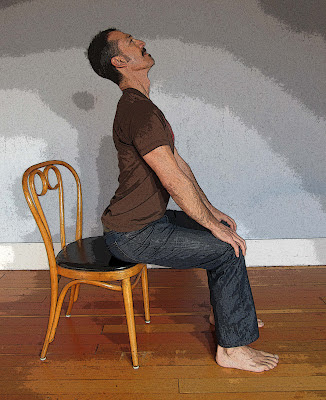by Nina
 |
| Cat Pose in a Chair |
Recently we’ve been featuring some yoga poses you can do while seated on a chair, such as a chair twist, backbend and forward bend. We’ve been offering up these poses as “office” or “travel” yoga, for those times when you don’t have the space or option of practicing on the floor. But it’s also true there are many people out there who cannot practice yoga standing up. They may have a chronic disease, such as Parkinson’s or Multiple Sclerosis, may have balance problems, or may be too weak to get up from the floor for any number of reasons. They may even be in a wheelchair.
To be honest, it’s only lately that I’ve come to realize what a godsend chair yoga can be for such people. As I’ve been learning more and more about the aging process, I’ve started to understand how important it is to keep moving your joints through their range of motion. If you don’t, you will continue to lose mobility, and very quickly (I watched my own father go through this when he stopped exercising). But if you do continue with your yoga, even while seated on a chair, you can help slow down your losses (and, maybe, depending on your condition, maintain or even regain some mobility). That was driven home to me this weekend when I took Shari Ser and Bonnie Maeda’s therapeutic workshop “Yoga for Neurological Disorders.” One of the students in the class shared her story with us. She is a middle-aged woman with an inherited form of Muscular Dystrophy who had been a yoga practitioner before she came down with the disease. As a participant in a study of people with the disease, she was told that keeping up with her practice during her illness was clearly helping her slow down the progression of her disease. She seemed both very committed to and very grateful for her practice. She was also an inspiration to others in the class, whether they were currently dealing with a neurological disorder themselves or were just, like me, interested in learning to help those who are.
And although I’ve read many books that talk about the benefits of chair yoga for people with chronic illnesses and even helped produce the photo shoot for one such book (Yoga As Medicine by Timothy McCall), Saturday was the first time I did a full practice of chair yoga myself. I have to say, I was eating a little humble pie during the practice, as some of the poses were more strenuous than I was expecting. One particular pose was a revelation to me. We did a version of Downward-Facing Dog where you sit on a chair facing a wall, far enough away from the wall so you can touch your fingertips to the wall when you bend forward. Start by sitting upright with your feet flat on the floor, hips-width apart. Then bending forward from your hip joints, bring your fingertips to the wall and walk them slowly up the wall, until they are in Downward-Facing Dog alignment, keeping your ears aligned with your arms. What a great shoulder opener and upper body stretch! I thought it would be wonderful for anyone who can’t bear weight on their hands due to hand or wrist problems, and I found it much more effective stretch—at least for me—than Half Downward-Facing Dog at the wall. My partner in the class and I decided to dub it “Quarter Dog,” and I hope to take a photograph of it one of these days.
If you are interested in learning more about chair yoga, Loren Fishman and Eric Small’s book Yoga and Multiple Sclerosis: A Journey to Health and Healing has some excellent examples (some even done in a wheelchair). And, uh, yeah, Yoga as Medicine also has a number of good ones. If you know of any other resources for these, do let me know!
Follow Yoga for Healthy Aging on Facebook ° To order Yoga for Healthy Aging: A Guide to Lifelong Well-Being, go to Amazon, Shambhala, Indie Bound or your local bookstore.


I want to thank you for posting this information about Chair Yoga. I can only afford so many books and have researched the internet to find more poses to offer. Also, I have years of Iyengar class background so have used that information to translate into postures that they students can do. Please keep giving more on these seated postures.
Thanks!!!
I teach a chair yoga class. We do standing poses along with seated ones, but always have the chair nearby in case someone needs to hold on for balance.
Peggy Cappy's videos offer a lot of good ideas. She has five, with a new one coming out in April. Her series is called Yoga for the Rest of Us, meaning those of us who are not young, not flexible, not thin. She shows lots of adaptations for people who can't do traditional yoga.
I teach Peggy's sun salutation, which has people placing the hands on the seat of a chair instead of the floor. That essentially raises the level of the floor, making sun salutations accessible for almost anyone. If a student has wrist problems, I have her put rolled up washcloths under the heels of the hands and that eases the angle.
Joanne
I took adaptive yoga for MS with Karen Clarke-O'Donnell years ago, and more recently Lakshmi Voelker Chair Yoga training. Wow. Awesome stuff!
gaileee
I would like to also recommend Lakshmi Voelker Chair Yoga – there are a DVD, CD, and teacher certifications available at getfitwhereyousit.com.
Chair yoga does have so many wonderful benefits in so many settings.
Have you seen Anywhere Anytime Any Body Yoga by Emily Slonina? It has some wonderful photos of people of all ages and sizes practicing chair yoga.
Also please check out http://www.sitnfitchairyoga.com. Sit N Fit Chair Yoga has been studied at Florida Atlantic University and significant benefits include pain reduction, pain interference, fatigue reduction and improvement in gate speed. This is Simple Chair Yoga for everyone and safe! Thanks, Kristine Lee
Thank you so much for this article. In addition to a really painful hip, I have major problems with both arms and I look for options like this one.
Chair yoga is such a wonderful way to make yoga accessible to everyone, regardless of mobility or experience level. I love how it encourages movement and mindfulness in a gentle supportive way. It’s amazing how small adjustments can still provide so many benefits. Thanks for sharing this.